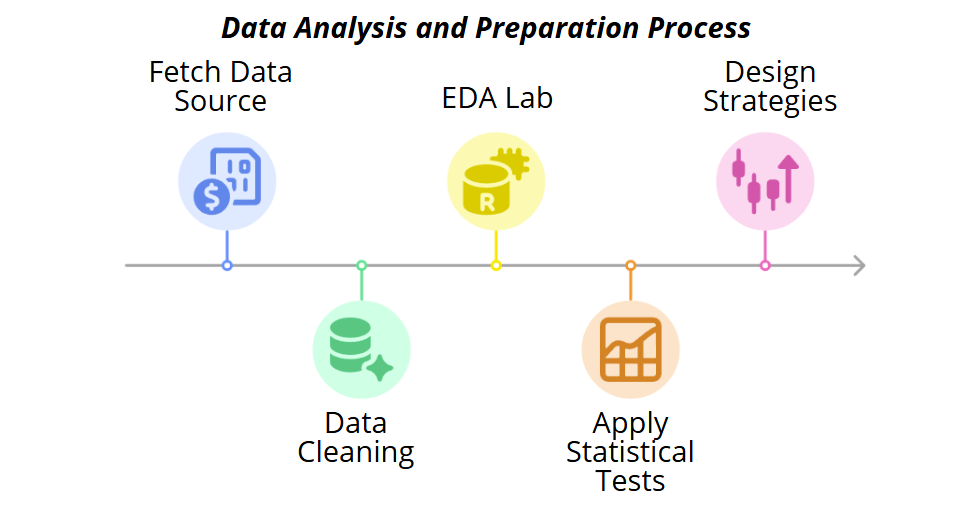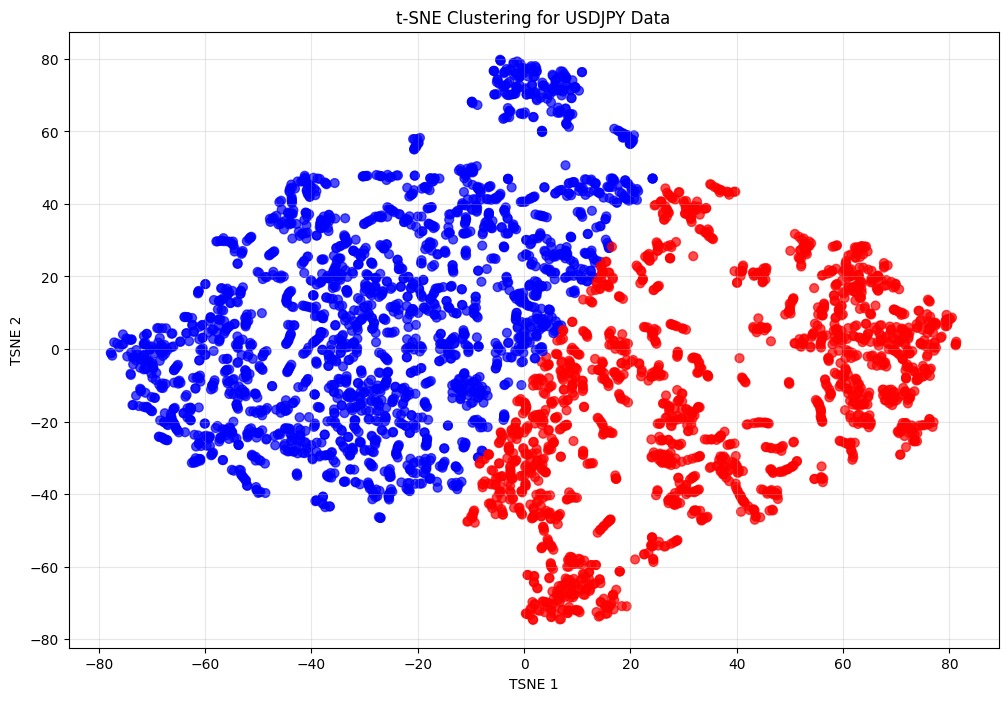Decoding Quantitative Trading
.png)
Introduction
Quantitative trading is a data-driven approach that leverages mathematical models, statistical techniques, and algorithms to identify and execute trading opportunities. Unlike manual or discretionary trading, which relies heavily on human judgment and emotions, quant trading is systematic, scalable, and objective. By analyzing vast datasets and executing trades in small timeframes, it minimizes emotional bias, enhances consistency, and captures market inefficiencies with precision. This makes quant trading especially powerful in today’s fast-paced, information-rich financial markets where speed and accuracy are key.
At P3, the Quantitative Trading Division of 2Cents Capital, we focus on delivering consistent, scalable alpha through systematic and data-driven trading strategies. We combine quantitative research, strategy engineering, and robust risk analytics within a cohesive, innovation-led framework.
Core Components
1. Quantitative Research
In our research team, we explore financial markets through the lens of statistics, econometrics, and machine learning. We work on signal generation, factor modelling, anomaly detection, and regime switching analysis. We rigorously backtest hypotheses using clean data in custom-built simulation environments. These research insights form the backbone of our alpha strategies.
2. Systematic Strategy Development
We transform research insights into live trading strategies using a modular, production-grade framework. Our strategies span multiple time horizons and asset classes (primarily Forex and commodities) and incorporate factors like momentum, mean reversion, value, and volatility. Our development process emphasizes backtesting, forward testing, and real-time monitoring to ensure robustness and performance.
3. Portfolio and Risk Analytics
We manage capital allocation through a dedicated focus on portfolio and risk analytics. This includes position sizing, drawdown controls, risk attribution, correlation analysis, and stress testing. Using real-time dashboards, we maintain full transparency on performance, risk exposures, and alpha drivers—ensuring portfolio stability even in volatile markets.
Infrastructure and Tools
We’ve built and operated on Synapse, our proprietary research and strategy development framework based on backtesting.py. Synapse standardizes the research lifecycle—integrating plug-and-play modules for strategy development, transaction cost modeling, alpha combination, and portfolio analytics. It helps us reduce operational overhead and maintain reproducibility across projects. Additionally, we have a Strategy Lab as well, where we seamlessly customize and enhance our strategies.
At P3, we operate at the intersection of quantitative rigor, strategic automation, and robust execution. Our vertically integrated structure, proprietary tooling, and commitment to continuous learning allow us to consistently deliver scalable alpha. We take pride in building strategies that not only perform but prepare us—and our firm—for long-term success in the fast-evolving world of quantitative finance.
To illustrate our pipeline in action, let us walk you through how the P3 team analyses data and develops a trading strategy from start to finish. For this demonstration, we will focus on the USD/JPY currency pair and guide you step-by-step through the entire process of strategy creation. This will provide a clear understanding of how raw market data is transformed into a systematic trading approach designed to perform effectively in live markets.
Data Analysis
In research, data analysis plays a critical role in developing effective predictive models and trading strategies. Statistical and Visualization techniques like Histograms, Boxplots, ADF Test, VIF Scores and Mutual information provide comprehensive insights into data distribution, stationarity, multicollinearity, and nonlinear relationships, enabling more robust feature selection, transformation, and model design tailored to complex market dynamics.
Data Lab is where we understand and prepare our data before any modelling or strategy development. We considered USDJPY Forex Data in our analysis.
Data Correction: The initial few rows often lack sufficient historical context for rolling window calculations. Carefully dropping these rows preserves integrity for subsequent computations without propagating NaNs or distortions. Now we have cleaned and correctly indexed data ready for EDA.
The EDA Lab Pipeline:
- Analyse the Distribution type of the features, to decide if they can be used in regime shifting or trending or mean reverting strategies. Understanding whether features exhibit normality, skewness, multimodality, or heavy tails helps determine their suitability for different modelling approaches. For example, features with stable, symmetric distributions may be better suited for mean-reverting strategies, while those showing trends or heavy tails might indicate regime-shifting characteristics.
- Apply the Augmented Dickey-Fuller (ADF) Test to check stationarity of each feature. Stationary (mean-reverting) features enable modelling approaches that assume stable statistical properties over time, crucial for many time series methods. This step ensures your data respects underlying modelling assumptions and informs whether a feature signals momentum, trends, or mean reversion dynamics.
- Uncover hidden nonlinear relationships via Mutual Information. This reveals complex dependencies that traditional correlation misses, exposing nonlinear interactions or subtle connections within the data.
- Explore data segmentation through t-SNE visualization to project the high-dimensional feature space into two dimensions for visualization. This method reveals natural clusters, grouping similar observations and potentially exposing different market regimes or behavioural segments. It also highlights outliers and anomalies that may warrant special treatment or exclusion.
- Address multicollinearity VIF analysis: Investigate multicollinearity among features with VIF scores to identify variables that are highly linearly related and potentially redundant. High VIF values suggest risk of inflated variance in coefficient estimates leading to unstable and less interpretable models. Streamline the feature set by identifying and removing redundant variables, improving model interpretability and robustness.

Histogram , Boxplots and Violin Plot:
A histogram combined with a KDE curve offers a comprehensive view of a feature’s empirical distribution. The histogram discretely visualizes frequency counts over value intervals, while the KDE provides a smooth, continuous probability density estimate derived from kernel smoothing techniques.
The position of the median within the box plot reveals data asymmetry, while clearly marked outliers help identify extreme values that may bias the model.
Inference
The OHLC price features (Open, High, Low, Close) of USDJPY exhibit a roughly unimodal distribution with slight right skew, indicating most prices cluster around a central range but sometimes spike higher. Boxplots show a moderate spread with several high-end outliers, reflecting occasional price jumps. Violin plots confirm these distributions are dense near the centre with asymmetry toward higher values. Volume differs notably, displaying a strong right skew with many low values and occasional extreme spikes. Its boxplot and violin plot reveal frequent, significant outliers due to bursts in trading activity. Overall, prices move cohesively with typical market behaviour, while volume has more variability and heavy tails.

Augmented Dickey-Fuller (Mean Reverting Test):
The Augmented Dickey-Fuller (ADF) test checks if a time series is stationary by testing for a unit root. Stationarity is vital for reliable time series modelling and strategies relying on mean reversion. Stationary features are mean-reverting and tend to oscillate around a constant level. A small p-value (typically <0.05) means the feature is stationary (mean-reverting), A large p-value indicates a non-stationary or trending process, which is better suited for momentum or trend-following models.
Inference
The ADF test results on USDJPY data show that price features (Open, High, Low, Close) are not mean reverting, indicating these price series do not tend to revert to their rolling mean. Whereas, Volume tends to be mean-reverting.
Mutual Information (MI) Matrix:
We have a feature set of 160 features to help us define the dataset and its behaviour we use MI to remove redundant and correlated
Mutual Information (MI) measures how much information two features share, capturing both linear and nonlinear dependencies. From the MI matrix values, very high scores between feature pairs suggest redundancy—they carry overlapping information. Low MI values indicate independence, so both features provide unique information and should usually be retained.
Inference
From the MI matrix values of USDJPY, very high scores between feature pairs with high redundancy and overlapping information are suggested to be removed. Low MI values indicate independence, so both features provide unique information and should usually be retained.
Mutual Infornmation(MI) between two dsicrete random variables X and Y is defined as:

where pxy(x,y) is the joint possibility of X=x and Y=y, and px(x), py(y) are the respective marginals. MI measures the reduction in uncertainity of one variable given the other, capturing linear and non-linear dependencies. In asset or feature analysis, a higher MI indicates stronger predective or shared information between asset features or returns.
t-SNE Visualization:
t-SNE is a nonlinear dimensionality reduction technique that projects high-dimensional data into 2D while preserving local neighbourhood relationships. It helps visualize complex patterns by maintaining similarities between nearby points in the original space.
Inference:
In the figure below, the daily USDJPY data points, each described by 160 features, are reduced to a 2-dimensional t-SNE plot. This visualization reveals clusters that represent different market conditions or regimes. Whenever we have a new data point it falls into any of the existing cluster, it tells about the current market regime.

Strategy
Strategy Overview:
This trading strategy for forex markets combines Bollinger Bands and VWMA to identify probable entry points.
Key Components
Indicators Used:
- Bollinger Bands (BB):
- Calculated using a 20-period moving average and a width set by 2.5 standard deviations.
- Identify when prices move far away from the average, indicating potential overbought or oversold conditions.
- VWMA (Volume-Weighted Moving Average):
- Represents the central trend, factoring in trading volumes, thus providing a stronger support/resistance level based on actual market activity.
Entry Logic:
- Aggressive Long Entry:
- Triggered when the closing price drops below the midpoint of the lower Bollinger Band and is above the VWMA.
- Intuition: Price has fallen below typical support and is expected to revert upward toward the mean.
- Aggressive Short Entry:
- Triggered when the closing price rises above the midpoint of the upper Bollinger Band and is below the VWMA.
- Intuition: Price has exceeded typical resistance and is expected to revert downward toward the mean.
Trade Execution:
- When entry conditions are met, the strategy:
- Closes any opposite open positions (to avoid conflicting trades).
- Opens a new position (buy or sell).
Risk Management:
- Stop Loss (SL):
- Set relative to current price, capped at a maximum of 20 price units (to prevent excessive risk).
- Calculated using the pip size inferred from the price's decimal format.
- Take Profit (TP):
- Set at a target distance (generally twice the risk, e.g., 0.02 for 2%), scaled by the current price.
- Position Sizing:
- Based on a fixed risk percentage (e.g., 1%) and the distance between entry and SL, ensuring consistent risk across
Trade Management:
- The strategy continuously monitors open positions:
- Closes opposing positions when a new signal appears.
- Enforces risk limits to prevent large drawdowns.
How It Works Mathematically:
- When price drops significantly below the mean (represented by the Bollinger Bands midline), and is above VWMA, it suggests a possible upward correction → Enter long.
- Conversely, when price exceeds the upper Band and falls below VWMA, it indicates a possible downward correction → Enter short.
- The thresholds depend on deviations from recent averages and volume confirmation, aiming to catch corrections rather than sustained trends.
Strategy Lab
Our automation pipeline includes a powerful tool called 'Strategy Lab,' developed by our team. This is how it works, the tearsheet generated is passed to this tool, and it will analyse the performance by examining various factors which will include macroeconomic factors like inflation, GDP, national income and other factors like Stock, bond, commodity, and other capital markets, interest rates, top 25 technical indicators chosen by the data analysis tests, sentiment analysis, and more relevant to forex assets. Based on this analysis, Strategy Lab provides targeted filters and insights to help identify where your strategy underperforms and how to optimize it for better results.
Analysis from Strategy Lab for current strategy
- For worst 5 maximum drawdown periods the value of RSI is < 25 for long positions and > 75 for short positions.
- Bollinger Bands multiplier (2.5) is giving false signals; reducing to 2.0 will better capture breakouts without false signals.
- Stop-loss limit (max 20 units) is too rigid; replace with ATR-based dynamic stop-loss for adaptation to current volatility.
- The returns are too volatile which reduces sharpe ratio, adding volatility condition would decrease drawdown and thus sharpe ratio.
Forward Testing:
Once a strategy has successfully passed our backtesting criteria, the next step is to test it in a real-time market environment—but without risking actual money. We do this by running the strategy in a simulated live setting, to see how it performs with current market conditions. This process is crucial because it helps us confirm that the strategy is not just effective on historical data, but also adaptable and reliable when faced with the uncertainties of today’s markets.
During this forward testing phase, we closely monitor the strategy over several months. We look at how well it performs, whether it remains consistent, and if it handles different market regimes—such as trending or volatile periods—appropriately. If the strategy continues to show strong and stable results throughout this period, we then consider it proven enough to move it into our pool of approved strategies.
From this pool, strategies are selected and allocated capital based on our overall portfolio management framework. This framework is designed to balance risk and reward by combining multiple strategies, ensuring a diversified and resilient portfolio. We will go into more detail about how this portfolio construction process works in our next edition.
Join Our Team
Explore More Blogs
Yes, You Are on the
Fintech banking advanced technology to offer agile, user friendly & services to traditional banking.




.png)
.png)

.png)
.png)




